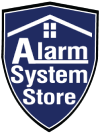Alarm System Sensors Explained
There are a multitude of sensors that can be used with alarm systems. Below you will find a brief description of the different sensors and their purposes.
Primary Intrusion Security Sensors
Door/Window contacts: Contacts used for doors and windows are interchangeable. They typically come in 2 pieces: the contact, and a magnet. When the 2 pieces are separated, they break a circuit connected to the system to tell it the door or window is open. The less common option is a button style contact, where depressing the button shows the door closed, and releasing the button shows open. Door and window contacts are your first line of defense by covering the perimeter of your home or business. Always cover any perimeter entry that is easily accessible to intruders.
Motion sensors: Motion sensors come in 2 varieties: Standard PIR sensors, and Dual-tech sensors. Standard PIR motions use infrared to capture heat signatures. Dual-tech sensors have 2 triggers that both have to be activated to actuate the sensor, an infrared sensor and microwave sensor. Motions are used to back up perimeter sensors. Motions work best when the movement they are intended to capture is perpendicular to the direction the motion is facing.
Glassbreak sensors: Glassbreak sensors are sensors that are typically set to always be active. They operate by listening for the frequency that glass makes when it breaks. Glassbreaks have a typical maximum range of 20-25 ft and require line-of-sight to the glass they are protecting. These are also used to backup perimeter sensors.
Shock sensors: Shock sensors are another type of window breakage detector that are place on the window, or on the frame of a window. The shock sensors work by detecting impact near where they are placed. Some shock sensors, like the PG9935 act as both a shock sensor and a window contact sensor.
Holdup/Panic buttons: Holdup and panic buttons are used for an immediate alarm condition in any event you deem worthy. They are exactly what you would expect, just a button that, when pressed, triggers 1 of 2 reactions. The first is an audible panic, setting off the siren and triggering an alarm response. The second, the holdup trigger, is only viable when you have Central Station service as it sends a silent alarm that will be dispatched on.
Primary Life-Saving Security Sensors
Smoke detectors: Smoke detectors are exactly what you would expect. Detectors capable of sensing smoke from a potential fire. These are a must have if you wish to have a Central Station dispatch on your alarm system as it will increase the chance to save your lives and home from a fire. Be aware that smoke detectors can have false alarms from dust if they are not cleaned regularly, or steam if they are in a kitchen.
Heat Detectors: Heat detectors are a great alternative to smoke detectors in areas where smokes could trigger false alarms. They operate by detecting a specific heat threshold determined by the sensor. Places where you will commonly use heats would be attics, garages, kitchens, and unfinished basements. Heat detectors are generally one-off style sensors, meaning once they are triggered they will need replaced.
CO (Carbon Monoxide) sensors: CO sensors are great to have in any home, as they can detect carbon monoxide before it becomes dangerous. Generally gas appliances are the main culprits in potentially producing CO, but it is never a bad idea to have one placed in bedrooms just in case.
Auxiliary Sensor Options
All of these sensors offer a different purpose over standard security and life-saving aspects. They are particularly useful when you are using a service like Alarm.com to self-monitor as these devices will be able to notify you of miscellaneous events. If you also have automation capability, you may be able to use these sensors as a trigger for an event. A great example is shutting off your incoming water line in case you have a leak.
Water/Flood sensors: These sensors can be used to protect your home from water damage. Generally a couple flood sensors near incoming water lines and water heaters can provide a very early warning of water issues. There is also a sensor dedicated to sump pumps overfilling.
Temperature sensors: Temp sensors are exactly what you would expect. They can monitor temperatures in areas of your home or business that may be vital. For example you can set a temp sensor in a freezer to alert you when the freezer warms up to a non-freezing temp. Some systems also have the capability to display the temperature of the sensors.
Natural gas detectors: While less common nowadays, some people may have tanks of natural flammable gas, such as propane, on their property or even inside of a building. These detectors can detect leaks when that gas is escaping into the air, and alert you that action needs to be taken.
